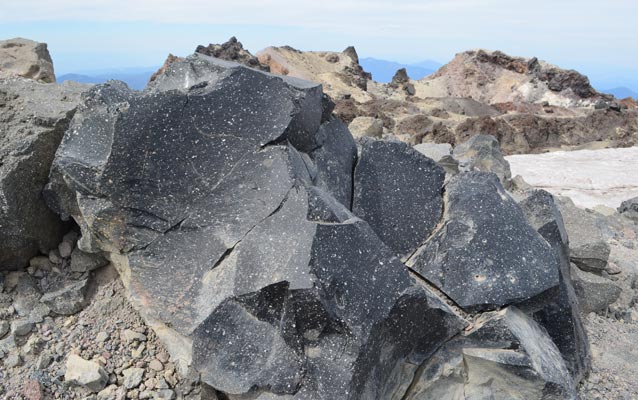Last updated: November 21, 2023
Lesson Plan
Earth Cookies

- Grade Level:
- Middle School: Sixth Grade through Eighth Grade
- Subject:
- Math,Science,Social Studies
- Lesson Duration:
- 90 Minutes
- State Standards:
- California State Standards
Essential Question
What do Earth Cookies tell us about geology and the past?
Objective
Students will compare and contrast different types of cookies and igneous rocks and classify them according to their structural make-up and ingredient composition.
Background
Although the average student is relatively unfamiliar with rocks, especially their composition and formation, most students are very familiar with cookies. In actuality, cookies and rocks have many similarities, especially in the ways that they are formed. For this reason, a careful study of cookies provides a great introduction to rock formation and structure.
The building blocks of cookies are flour, butter, eggs, sugar, and baking soda. When the ingredients are mixed together, they create a substance that is not at all like the individual ingredients. The texture changes when the dough is heated. The exact same dough will produce very different results depending on the amount and type of heat to which it is exposed (the gooey cookie, the perfect cookie, the burnt cookie).
The process that produces cookies is similar to that which produces igneous rocks. The building blocks of rocks are various minerals. These ingredients can be mixed together to produce a variety of rocks. The degree of heat, water, pressure, and friction change the characteristics of the rocks, as does the way the rock cools.
Rocks can be classified using many criteria including but not limited to: weight, color, hardness, and where and how they originated. Rocks are classified into three main groups: sedimentary, metamorphic, and igneous rocks.
Sedimentary rocks are formed when different materials are laid down one on top of the other. They are characteristically layered and are formed by either deposits of previously weathered rocks, dead marine organisms, or crystallized chemical precipitates. Sandstone, shale, and limestone are examples of sedimentary rock.
Metamorphic rocks are made deep in the earth. Any kind of rock can be turned into a metamorphic rock by heat, pressure, or penetration of hot fluids. For example, shale will metamorphize into slate, sandstone becomes quartzite, and limestone will alter to marble.
Igneous rocks are made from magma that has cooled and solidified. When it cools beneath the surface, it is called intrusive igneous. Generally, intrusive magmas cool deep within the earth in an insulated environment. Crystals have time to grow large enough to be seen without magnification. When magma cools above the surface it is called extrusive igneous. This magma cools very rapidly when exposed to air resulting in smaller crystals or no crystals at all. Crystals do not have time to form. Granite is an example of intrusive igneous rock. Basalt and dacite are examples of extrusive igneous rocks.
Preparation
Cookies: this activity will be more meaningful if the students make the
cookies instead of buying them. Ask for student volunteers to make cookies the day before
you do this activity. Enough cookies should be made so that there will be one of each type per
student. Simple recipes for the four cookie types needed are included on the Recipe Page.
You can photocopy individual recipes and send them home.
Paper towels, two sets of four different types of igneous volcanic rocks (basalt, andesite, dacite, cinder, pumice, etc.), one metamorphic rock, one sedimentary rock, recipe page, worksheets, pencils.
Materials
Printable worksheets and cookie recipe.
Procedure
- Preparation of cookies. This activity will be more meaningful if the students make the cookies instead of buying them. Ask for student volunteers to make cookies the day before you do this activity. Enough cookies should be made so that there will be one of each type per student. Simple recipes for the four cookie types needed are included on the Recipe Page. You can photocopy individual recipes and send them home.
- Discuss the differences between the three rock types and introduce the lesson. Explain that the students are going to learn more about igneous rocks, specifically the extrusive rocks that come out of volcanoes.
- Pass out the cookies, paper towels, pencils and the Cookie Worksheet. Instruct the students to observe the cookies carefully. Many of the questions do not have right or wrong answers. Have students fill out the worksheet.
- Put the rocks out on a table. Label and number the rocks 1 through 4.
- Working in groups or individually have the students observe the rocks and fill out the Rock Worksheet.
- When all the students have completed their worksheets, discuss their findings. Compare and contrast the similarities between the two mediums.
- When finished with the activity, eat the cookies!
Vocabulary
geology, igneous, metamorphic, sedimentary, rocks, Rocks and minerals, cookies,
Structure, Composition, Characteristics, Classification, Minerals, Ingredients, Igneous, Sedimentary, Metamorphic
Assessment Materials
Students describe and list three similarities between cookie and igneous rock formation. Have students describe how they identify the differences between different igneous rocks. Have the students write a story about the formation of a volcanic rock.
Supports for Struggling Learners
- At home students can experiment with cookie dough. Try changing the composition just slightly and see what happens. Bake them at a higher or lower temperature, bake them for shorter or longer than called for, melt some cookie dough in a pot on the stove top, bake a cookie in a microwave, or throw a hot cookie in the air. What happens to it?
- Have the students look for igneous rocks in their neighborhood and bring them to class.
